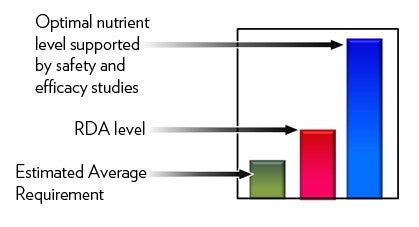Understanding the Nutritional Gap – RDA vs. Optimal Intake
February 23, 2015
Are you one of the millions of people who tries to eat right but finds that life gets in the way? Too often─ a lack of healthy food options combined with our hectic lifestyles make it challenging to achieve optimal nutritional intakes.
The Right Amount
Recent nutritional surveys indicate that more than 90% of adults do not obtain even the most basic level of nutrient intake for vitamins D and E; and more than 50% of adults are not meeting basic levels for vitamin A, magnesium, and calcium1. This is based on Estimated Average Requirements (EARs), which are nutrient levels lower than the Recommended Dietary Allowance (RDA). RDA is the average dietary intake level sufficient to meet the needs of nearly all healthy individuals in a group.
So, if we can’t even meet EARs, then just imagine how few of us obtain RDA levels of essential nutrients. But even RDAs are not always the bench mark of optimal nutrient intake. Many of these levels of nutrients were designated for some nutrients to only prevent nutritional deficiencies. Although RDAs provide guidance to help societies avoid deficiency, there is a significant difference between preventing deficiency and obtaining optimal nutrient levels. Clearly, the adage “the more the better” could be taken to extremes with vitamin/mineral intake, but studies show that in some cases certain nutrient levels above the RDA may deliver additional benefits.

The Safe Amount
As an example, let’s take a look at a hypothetical vitamin C intake during a single day consisting of: 1 cup of strawberries, 1 cup of orange juice, 1 cup of diced tomatoes, 1 cup of diced potatoes, and 1 cup of lettuce, to achieve 5 cups of fruits and vegetables per day (much better than the average intake of fruits and vegetables2). These foods would provide a total of 277 mg of vitamin C3. That is more than 400% of the recommended daily value. 277 mg of vitamin C might be alarming at first, but when you realize this is well beneath the safe Upper Intake Level (UL) for Vitamin C, which is 2,000 mg, you begin to realize that RDAs may be lower than optimal nutrient levels for certain nutrients. This is just one example – a similar analysis could be conducted for many vitamins and minerals.
So, how do we at Pharmanex use nutrient intakes to formulate a product like LifePak? There are several factors we take into account as we determine the dose of each ingredient in our premium nutritional foundation product:
1. We reviewed the scientific literature to determine optimal nutrient levels; levels to support health benefits beyond mere avoidance of nutrient deficiency.
2. We determined typical nutrient intakes from foods, and assess the nutritional gap between dietary intake and optimal intake.
3. We have taken into consideration the ceiling of safe nutrient intake, such that dietary supplement and food sources of vitamins and minerals, when added together, do not exceed safe upper limits.

NU SKIN TIP:
Take your LifePak with a meal to optimize maximum absorption.
![]() TWEET THIS
TWEET THIS

NU SKIN RECOMMENDS:
LifePak - a nutritional anti-aging program formulated to nourish and protect cells, tissues, and organs in the body with the specific purpose to support healthy aging.
We also considerd the bioavailability and stability of each nutrient, as well as nutrient-nutrient interactions, and more. Our formulation scientists reviewed published scientific literature to arrive at the dose of each ingredient in order to achieve optimal nutrition. But LifePak doesn’t stop at vitamins and minerals; we also include phytonutrients (plant compounds) known to be generally beneficial and which are often missing from our diets. LifePak is much more than a product designed to prevent deficiencies—it is a product designed to achieve optimal nutrition. Don’t just supplement to prevent deficiency, supplement for optimal health. ■

Written by:
Tanner Gibb
Technical Comm/Education Manager
Pharmanex
1) Fulgoni VL 3rd, Keast DR, Bailey RL, Dwyer J. Foods, fortificants, and supplements: Where do Americans get their nutrients? J Nutr. 2011 Oct;141(10):1847-54.
2) Casagrande SS, Wang Y, Anderson C, Gary TL. Have Americans increased their fruit and vegetable intake? The trends between 1988 and 2002. Am J Prev Med. 2007 Apr;32(4):257-63.
3) U.S. Department of Agriculture, Agricultural Research Service. 2014. USDA National Nutrient Database for Standard Reference, Release 27. Nutrient Data Laboratory Home Page, http://www.ars.usda.gov/ba/bhnrc/ndl. Retrieved online Dec. 21, 2014.
YOU MIGHT ALSO LIKE:
-
An old dogma is that we cannot do anything about how we age, it is simply programed into our bodies however, new research has identified that lifestyle choices can either slow or accelerate the aging process.
-
Did you know your skin is at war? Every day there is a constant battle between your healthy skin cells and the free radicals that seek to destroy them. The food you eat and supplements you ingest aid in your body’s ability to combat these free radicals. But how do you know if your body is getting the proper amount of antioxidants needed to win the war? The answer lies in a device designed specific...


